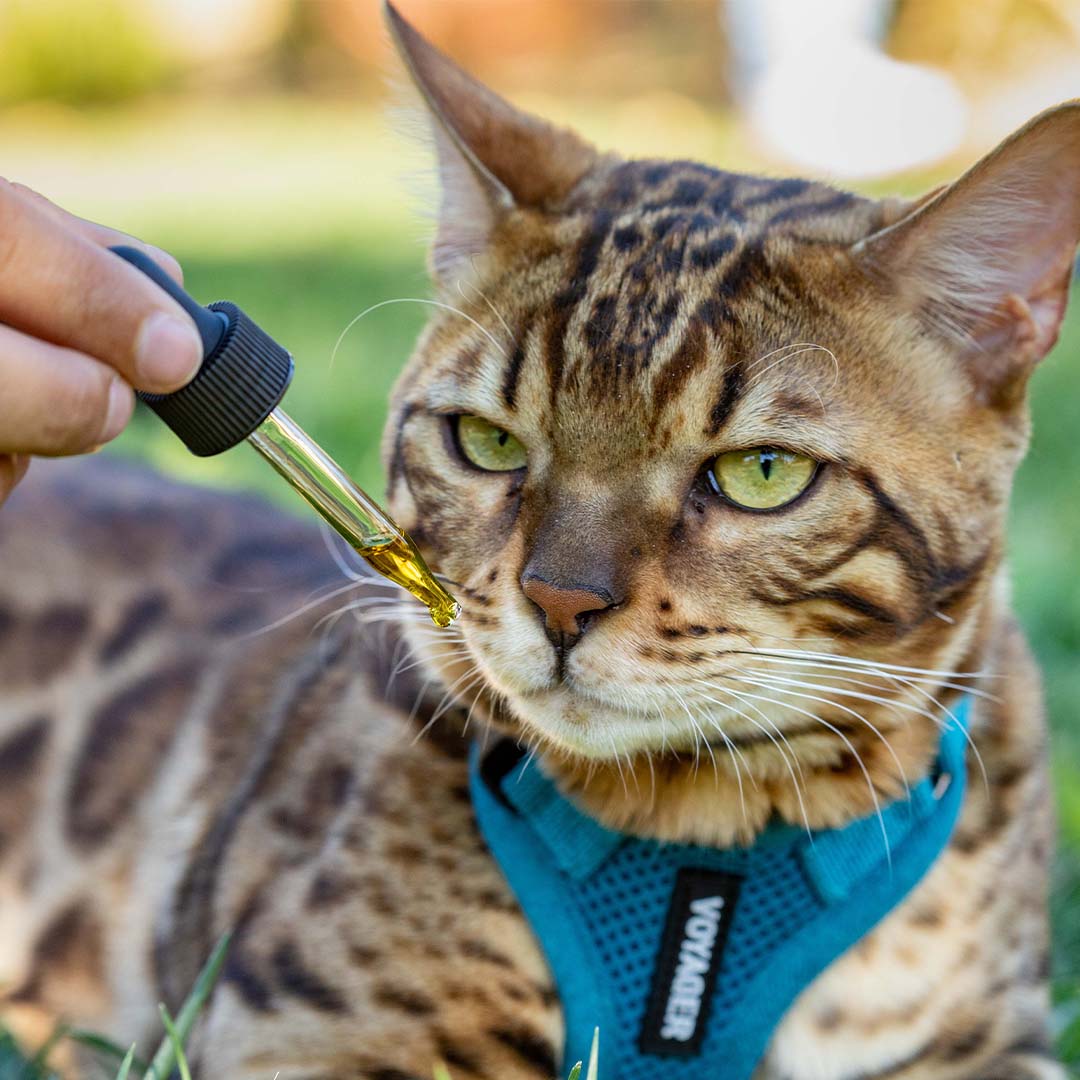Cats can be highly territorial and solitary animals, so it can be a stressful process if you're about to introduce a new kitten to the family. It's important for cat owners to learn warning signs when introducing cats like hissing or clawing, as well as the proper procedures for first-time meetings. If you take it slow and monitor their behaviors in the beginning, you'll be able to have a peaceful and friendly home!
A lot of people wonder how to introduce cats — they're particular creatures after all. So, let's take a closer look at why cats act the way they do when a new kitty is introduced. There are also a few things you can do to make your current cat and new cat get used to each other in the safest and most effective way possible!
Do Cats Naturally Get Along?
Every cat has its own unique personality, which influences how they handle social interactions. Some cats thrive with a fellow feline companion, while others prefer to have you all to themselves. The reason that cats have a tougher time meeting new pets in general compared to a dog is that they are extremely territorial animals. Picture a big cat out in the wild.
Almost all of them are loners, ruling over a territory they've claimed. They hunt, sleep, and even guard their territory alone. Cats were domesticated by choice when they noticed a lot of small rodents around human settlements. This ended the cat's traditional solitude but didn't quite rid them of their territorial nature.
When you adopt a cat, you and your home become their territory. That's why many cats become aggressive or threatened when a new cat is plopped into the territory they once ruled over without interruption.

Do Male and Female Cats Get Along?
Assuming all cats in this scenario are properly neutered and spayed, male and female cats can be introduced in the same household without the gender playing too much of a role in their friendliness towards each other. But cat experts have noticed some patterns in cat behavior that may help when considering the gender of your new cat.
Do Cats Get Along With The Same Gender?
Research out of Switzerland found that cats will often be more compatible with a cat of the opposite sex. When it came to same-sex introductions, males were more likely to get along than two female felines. That's because female cats have been known to be a bit more assertive and aggressive than their male counterparts. While all cats are individuals, many owners and cat rescue workers have noticed that female cats can be a bit bossier, whether it's demanding attention or ruling over their domain.
How Long Does It Take For Cats To Get Along?
It can take up to about 8-12 months for a cat to develop a friendship with another cat. However, some cats never really become close friends and just learn to tolerate each other. If cats start fighting when they are first introduced and continue to do so, one of the cats may have to be re-homed.
Do Older Cats Get Along With Kittens?
It's natural for older cats to take a little time to adjust to the arrival of a new kitten in the house. Some cats never quite get used to having a kitten around, but usually, they will at least coexist peacefully. It's important to be patient with your older cat and give them time to get comfortable with the new family addition. In the meantime, be sure to provide plenty of toys, playtime, and separate spaces so that everyone in the household can enjoy themselves.

Do Some Cat Breeds Not Get Along With Other Cats?
Cats naturally have a solitary instinct, leading some to assume that certain breeds may not get along well with other animals, particularly other cats. However, this is generally not always the case. Some breeds can be more social and adaptable, so it's important to do your research before bringing home a second cat.
By choosing compatible or friendly breeds, you can help ensure that everyone gets along peacefully. Of course, each cat can have its own personality that may be more or less friendly. Some of the most well-known sociable cat breeds are:
- Exotic Shorthair
- Scottish Fold
- Ragdolls
- Abyssinian
- Russian Blue
- Burmese
What Happens If You Introduce Cats Too Quickly?
If you're thinking about getting a new cat, it's important to know how to introduce them to your existing pet. Too often, people make the mistake of introducing them too quickly, which can lead to several problems. Introducing cats too quickly can make them feel threatened by each other's presence.
Cats are naturally very territorial animals. Because of this, if they are introduced too quickly, they may feel threatened and scared, which can lead to aggressive behavior. First impressions tend to create a lasting effect! If your cats do not immediately take a liking to each other, don't worry! There is a chance that they can grow closer or at the very least trust each other enough to live in peace.
Giving them the time and space to adjust increases this likelihood. Just remember to take things slow and give both cats plenty of time to get to know each other.
How to Introduce Cats to Each Other
There are a lot of factors to consider before adopting a new cat and introducing them to your current kitty. If you're unsure how your cat will react, it's often safer to adopt a kitten or younger cat. This will make the new arrival less of a threat to your existing pet, although some proper introduction steps should still be taken to ensure safety and the least stress possible.
Before you bring your cat to its new home, make sure you have a room set aside for them that can't be accessed by your current cat. This room should not be your cat's favorite space, since they should have this area themselves to make them more secure. Inside the separate room, have an area where the new cat can hide if they are afraid. Also have a comfortable sleeping spot, bowls for food and water, and their own litter box.
Consider putting a calming diffuser in the room, as well as in your cat's favorite spots. This reproduces cat facial pheromones, lowering their stress levels. You can also have some calming chews ready for both cats to make them more relaxed in an otherwise tense situation.

Related: CBD For Cat Anxiety - How To Calm With Cannabidiol
For your resident cat, make sure they have space in your home they currently enjoy. This could be a cat tree, cat shelves, or a spot on the sofa. This will be where your cat feels safe and still in control despite the "intruder" coming into their territory. This will eventually be where they spend time when they want to feel relaxed or safe.
How to Introduce Two Cats - Step By Step Directions
Introducing cats can be easy if you plan ahead and do some prep work. To avoid any feline outbreaks it's best to gradually introduce your cats to each other. This will give your pets the proper amount of time to get to know one another instead of just grouping them up right away. If there are any potential problems, a slow introduction will keep any violence to a minimum.
Follow these 5 simple yet effective steps.
Step 1: Avoid Initial Contact
When you bring the new cat home, make sure you make a beeline for their room. There should be no contact with your current kitty. Once the door is shut, place the new cat in a corner of the room or in an area they can hide. Don't force them to come out. You might even want to give the new cat some alone time to settle down and start exploring the new space.
Step 2: Introducing Cats by Scent
The next stage is to introduce the cats by scent. A blanket or towel your new cat has been using should be placed near your current cat's favorite space. You may notice your cat getting visibly upset by this, even hissing. If that happens, place it on the floor away from your cat's food or space, moving it closer to where they eat each day. Meanwhile, give your new cat something with your current cat's scent, so they can also get used to their smell.
Step 3: Swapping Food Bowls
Once they don't seem overwhelmed by the presence of the other's scent, try swapping the food bowls when feeding the cats. This could potentially build positive association with cat food and the scent of the new feline friend. If they seem calm after this exchange, you can move to visual contact. This could take just a couple of hours to a few months.
Step 4: Utilizing a See-Through Barrier
At this point, the new cat should still be in their safe room. Start letting them see each other by opening the door and placing a screen or baby gate. You can also just open the door slightly so they can see each other without being able to physically interact. Give them cat treats when they're near each other or encourage them to play with a variety of toys.
Step 5: Removing the Barrier
When your cats are feeling comfortable around each other after a few days, they might start to smell each other or touch noses. If there's no growling or hissing, you can take the current barrier away. Open the door and let them meet face-to-face.
Remember not to pick them up and force them to go near each other. They will make introductions on their own. They may choose to be far away from each other at first. If the cats start to fight, try making a loud noise that catches them off guard.
Monitor For Warning Signs When Introducing Cats
When introducing two cats, it's important to be aware of any potential warning signs that could indicate aggression. If the cats hiss or swat at each other during the initial meeting, this is a sign that they may not be ready to become friends just yet. The cats might also show signs of aggression by arching their backs, baring their teeth, and circling each other.
It's important to closely monitor their behavior during the first introduction and be prepared to separate them if necessary. Most cats will eventually learn to get along with a little patience and supervision.
Warning Signs When Introducing Cats
When you introduce cats for the first time, it won't necessarily always go according to plan. They may keep growling and hissing at each other from opposite sides of the screen, meaning you have to separate the cats for longer than expected. They might even swat at each other or chase each other through the house. It's definitely not an easy time for you or the cats!
But when you take your time and ensure that your cats are comfortable before each step, it'll be worth it when you see them curled up on the cat tree together or tolerating each other on your bed. While there are definitely going to be periods of frustration, fear, or stress, there are certain warning signs to look out for that may mean you need additional help from a veterinarian:
- Fighting for long periods of time
- Cats are injured from fighting
- One of the cats starts hiding constantly
- Cats are no longer eating
- One of the cats isn't using their litter box
- One cat starts spraying their territory
- Extended eye contact
Is Hissing Normal?
You will probably witness some hissing when you introduce two cats. That's to be expected and one of the first warning signs when introducing cats. Unlike dogs — who seem to be a bit more expressive — cats can be more difficult to read. They communicate mainly through body language and sometimes it can be a bit subtle.
If your cat is being aggressive, you'll notice they may be in a straight, stiff stance. Their tail will also be stiff, usually pointed downward. You will also spot the fur along their spine standing on end and their tail becoming a bit fuller. They'll often directly face the other cat, even staring right at them. They may move towards the other cat, growling or hissing.

You should step in if you notice these warning signs when introducing cats:
- Biting
- Fighting
- Yowling and shrieking
- Violent scratching
- One cat rolling onto its back in anticipation of the other cat attacking
Related: How to Calm an Aggressive Cat [8 Easy Tips]
A defensive cat — who is more afraid than hoping for a fight — will crouch lower to the ground, their tail possibly tucked in. Their eyes will be wide and their ears will flatten against their head. They'll turn sideways, not directly facing the other cat. They may even reach out for a quick strike with their claws out, warning the other cat to back off.
Introducing Cats to Each Other Quickly
We're going to be frank here: You probably won't be able to introduce two cats to each other quickly, especially if they're both adults and have had no prior interactions.
If you need to introduce two cats quickly, consider adopting a kitten. Your current cat will not feel as threatened and will be able to maintain their status as the boss of their territory. How to introduce a cat to a kitten still requires you to follow the instructions from above, but the process will move exponentially faster since your current cat — or cats — will make it known pretty quickly that they are not to be messed with.
More often than not, the kitten will be more bothersome than a threat. Make sure that your current cat has their own space just for them when they want to get away from a troublesome kitten. Cat shelves that require a bit more strength and length to get to are ideal since the kitten won't be able to follow your cat there when it needs a break.
How Do I Know If My Cats Get Along With Each Other?
There are also some clear signs to look out for that can indicate your cats are comfortable around each other and maybe even like one another! Look out for these signs when introducing two cats to see if things are going well!
Caressing Heads Together
Cats have a unique way of communicating that involves rubbing their heads together. By doing this, they leave behind a scent that they can recognize. This helps them stay in touch with each other and lets them know who is part of their social group.
Touching Noses Together
This behavior is known as 'greetings rubbing' and is a way for cats to exchange scent information. They can get a good sniff of the other cat by touching noses. Because so much of the way that cats communicate is done through scent, this behavior is important for cats sizing each other up.
Grooming One Another
Cats who help clean each other have a heightened level of trust that shows they like each other. Most cats are not comfortable with strangers helping them to clean, so if you see your cats taking turns grooming each other, it's a good sign that they're already friends!
Sleeping Together
Sleeping or napping together is one of the ways animals show comfortability with each other. Cats are letting their guard down enough to fall asleep together by sleeping together! If you see your cats take naps together, cuddle, or lay over each other, they've already started to develop ever-lasting bonds. It also shows they're having a great time and feel safe with each other.
Sharing A Space
As they are territorial creatures, if they play together or share toys, they're off to a great start. Especially if you see them sharing cat trees, scratching post, litter boxes, or even the food bowl, they may already be best buds. In most cases, this may take some time, so prepare separate toys and litter boxes until they get used to each other's presence.
Play Fighting
You might see your cats rolling and wrestling around, but it may not be what it seems. One of the main indicators of friendly behavior is when they play fight for fun! Just make sure their claws aren't out or hissing at each other. Play fighting is common is a great way for them to let off steam, explore their boundaries, and practice their hunting skills.
So, if you see your cats jumping around and pawing at each other, there's no need to worry - they're just having a little bit of harmless fun!
What Not To Do When Introducing Cats
The last thing you want to do is ruin a potential friendship by rushing introductions or not paying attention. Just like people, cats need some time to warm up to others. But to be sure we have covered everything, here is a list of what not to do when you introduce cats:
- Putting cats together right away
- Leaving cats unmonitored before they get along
- Introducing them in a noisy environment
- Ignoring or not looking for warning signs
See More Helpful Care Tips For Cats
Final Thoughts - Warning Signs When Introducing Cats
It may not be the most pleasant experience you've had — and the cats will most definitely agree. But with the right precautions and recognition of warning signs when introducing cats, you can safely add a new member to the family. Just remember that all cats have different personalities and preferences. Some cats may get along immediately while some will need months to be comfortable around each other. Check out this link to learn more about Holistapet.








![Probiotics For Dogs [Soft Chews]](http://www.holistapet.com/cdn/shop/files/Probiotic-Infographic-1_472d7a29-e30c-435a-9638-1365d8c3a9f9.jpg?v=1725384841&width=104)

















![Can I Give My Cat Melatonin? [The Answer Might Surprise You]](http://www.holistapet.com/cdn/shop/articles/21._Can_I_Give_My_Cat_Melatonin.jpg?v=1718134676&width=500)












Leave a comment
This site is protected by hCaptcha and the hCaptcha Privacy Policy and Terms of Service apply.